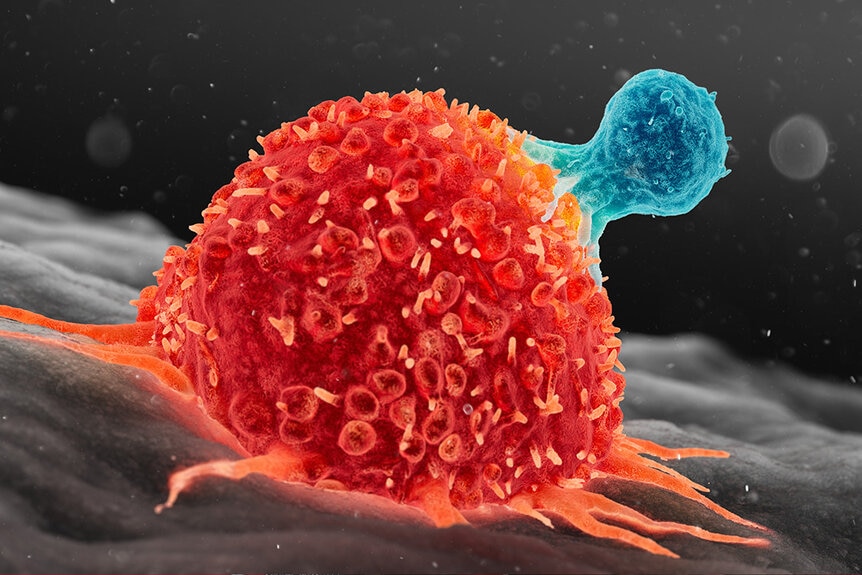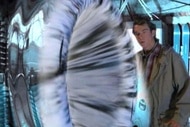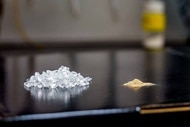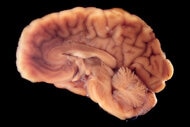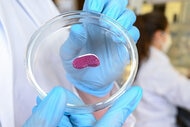Create a free profile to get unlimited access to exclusive videos, sweepstakes, and more!
Scientists Destroy 99% of Cancer Cells Using "Molecular Jackhammers"
Time to break out the power tools in the fight against cancers.

The holiday season can be a source of oversized emotions. We tend to be at our highest and our lowest during the holidays, when everything feels a little bit larger than life. For some, the holidays are the most fun they have all year and for others it’s quite literally hell on Earth. No one understands that better than the Grinch, a green-furred creature who hates Christmas from the deepest parts of his shrunken heart.
Director Ron Howard turned in a meditation on love, growth, and slapstick comedy in the 2000 live action film How the Grinch Stole Christmas, starring Jim Carrey as Dr. Seuss' titular villain. We, the viewers, experience the beginning of the Who’s holiday season the same way the Grinch does, through the gentle tones of Christmas carols drifting into his mountain home from Whoville below.
RELATED: Cyborg Locusts Can Detect Cancer by Smelling Your Breath
The Whos are singing Christmas music both joyful and triumphant and the Grinch tries everything he can think of to drown them out. He covers his head with a pillow, turns on half a dozen blenders, powers up a giant monkey crashing oversized cymbals, and then starts jackhammering his own floor. Anything to drown out the sounds of Christmas cheer. It’s all a little over the top but we get it, when you’re backed into a corner you’ll try anything, even if it means punching through your own floor. Recently, scientists took a page out of the Grinch’s book when they developed “molecular jackhammers” capable of destroying cancer cells by shaking them to death.
How Scientists Are Vibrating Cancer Cells to Death
In a new study published in the journal Nature Chemistry, scientists used aminocyanine molecules and near-infrared light to break the membranes of cancer cells in the lab. Aminocyanines are commonly used in bio-imaging dyes because they are good at attaching to cells. A low dose makes images clearer, so that doctors can more easily see what’s going on inside of you.
Aminocyanine molecules readily attach to the outside of cells because they are positively charged and latch onto the negative charge of the cell's phospholipid bilayer. When activated with light, the electrons inside the aminocyanine molecules create plasmons which excite the entire molecule and cause it to vibrate. The vibrations happen super fast, in less than a picosecond (one trillionth of a second), and they are powerful enough to punch through the cell membrane and destroy it. These destructive vibrations caused researchers to call the aminocyanines "molecular jackhammers," for the way they pound on the floor of a cell until it breaks apart.
“These molecules are simple dyes that people have been using for a long time. They’re biocompatible, stable in water and very good at attaching themselves to the fatty outer lining of cells. But even though they were being used for imaging, people did not know how to activate these as plasmons,” said Ciceron Ayala-Orozco, lead author on the study, in a statement.
RELATED: Enacting siege warfare to successfully starve and kill brain tumors
The process killed approximately 99% of melanoma cells in isolated lab tests, but that’s not necessarily an indication it will work inside the body, especially because the molecules have to be activated by light, which is famously in short supply inside the body. However, because this process uses near-infrared light instead of visible light, it’s able to penetrate more deeply into the body, potentially allowing these molecules to treat tumors and cancer cells in deep tissues, like inside bones and organs.
The real test was to see what happens in a living animal when treated. To that end, scientists tested the new method on mice with melanoma. Half of the animals were totally cancer free after treatment.
We know that the Grinch really just needed a friend to fix his broken heart, but sometimes taking a jackhammer to your own home is exactly what you need to heal.
Ron Howard’s How the Grinch Stole Christmas is available now from Universal Pictures.
